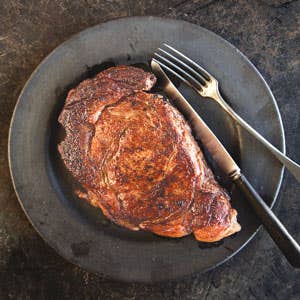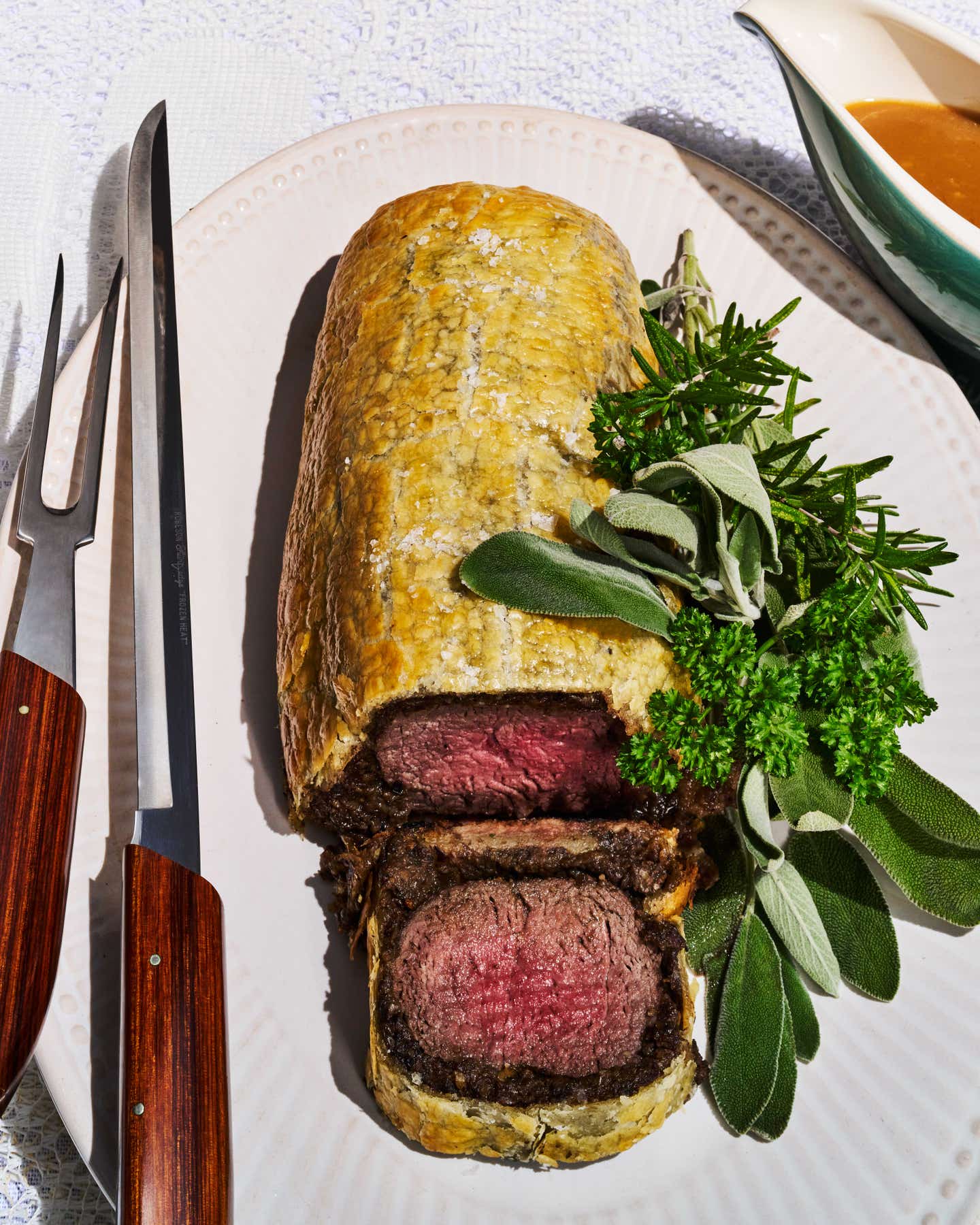
No other food arouses our appetite like a just-grilled steak. Lightly charred on the outside, juicy and tender within, and garlanded by luscious fat, it promises satisfaction both primal and refined. Little wonder, then, that it has attained an almost mythic status in our culinary culture. Indeed, the story of steak—the ways we cook and eat it and, just as important, the ways we raise the cattle it comes from—continues to unfold alongside the story of our nation itself.
Nothing expresses the flavor of beef better than a good steak—an ability that owes, in part, to the food's simplicity. The quick cooking over high heat of a modest-size cut of beef, taken from any of the more tender muscles of a steer, is a triumphant union of practicality and taste. Though steak has European origins—the word itself is derived from the Old Norse steikja, which means to roast on a spit—it is fair to say that the food didn't really come into its own until it crossed the Atlantic. Indeed, steak has in many ways become a symbol of the American dream: it is both a staple of the workingman's table and an icon of material achievement.
Our country's appetite for beef and, particularly, steak has fundamentally changed the social, economic, and even physical landscape of the United States. It has made entrepreneurs rich, spawned cities and towns, launched restaurant empires, and inspired a culinary lexicon all its own. Yet it remains an enduring emblem of our frontier history, evoking the legendary romance, innocence, and violence of the American West. In fact, if you want to go to the source of some of the best American steak, you still have to travel to the country's Western states, to places like the 88,000-acre La Cense Montana ranch, in the southwestern part of that state, one of the oldest continuously operating cattle ranches in the country, established in 1869.
Although a century and a half of industrialization has helped make steak as commonplace as bread in many American households, beef producers like La Cense are returning to more-meticulous ranching methods that reflect the way cattle used to be raised in this country (and still are in places like Argentina)—that is, on native pastureland. Their labors are yielding some of the most extraordinary steaks I have ever tasted—marbled and juicy and cut from Black Angus steers and heifers that eat nothing but grass in their lifetime. For me, visiting La Cense—and seeing how such an enterprise fits into the complicated history of beef in America—is key to understanding, in a visceral, historical, and economic sense, where my steak comes from.
First a pair of tiny black hooves appears, followed by the nose, the head, and, with an earth-shaking moo from the mother, the rest of a newborn calf, which lands in the cool grass right in front of me. Mama turns to lick her baby clean while Dan Hill, a 66-year-old La Cense cowboy who wears a miner's lamp strapped to his hat, puts a drop of antiseptic on the umbilical cord and attaches a numbered tag to the calf's ear. This is the fourth birth of the night; by tomorrow night there'll be a dozen more, adding to a herd that already comprises roughly 700 steers, 2,000 mother cows, 1,000 yearlings, and 2,000 calves.
During spring calving season, Hill and the other ranch employees are as much medical technicians as cowboys. Using ultrasound, they were able to predict exactly when the cow we've just watched give birth would go into labor. Sometimes, Hill tells me, if the mother takes too long, they'll move her into the calving barn, a maternity ward-like facility. If a mother has twins, they'll take one of the calves and feed it by hand every six hours until they find a surrogate mother who's lost her own calf—since one of a pair of twins left with its birth mother most often won't survive once it enters the herd.
"You can't learn it from books," 69-year-old ranch manager Bud Griffith tells me the next morning as he shows me around the ranch's facilities. "Cowboying's a way of life." But as I learned last night, that doesn't mean that ranchers like Griffith and Hill are stuck in some storybook past.
William Kriegel, La Cense's 62-year-old owner, is one of a growing number of advocates of what's known as "natural ranching". For Kriegel, a native of France who owned an energy company before becoming involved in ranching two decades ago, that means running a ranch that integrates cattle raising with programs focused on equine studies. It also means operating outside the industrialized beef system—where more than 99 percent of American beef comes from—and not placing blind faith in USDA descriptions like "prime" and "choice", which identify fat content and age as the major determinants of flavor (see "Grading Beef"). It also means raising hormone- and antibiotic-free cattle whose meat can be called exclusively grass-finished—that is, animals that have grazed in open pasture from birth to slaughter.
These practices represent a dramatic departure from the way most beef is generated in the U.S. nowadays and, at the same time, a return to methods that flourished prior to World War II. It is impossible to calculate exactly how many producers are raising grass-finished cattle, since many do not market their meat as such. According to data compiled by the National Cattlemen's Beef Association, natural and organic (which generally means hormone- and additive-free) beef accounts for less than 2 percent of U.S. retail beef sales—but its sector is growing faster than that of conventional retail-marketed beef.
In 2000, when Kriegel bought La Cense from the Japanese-owned company that had owned it for 12 years, the cattle being raised there started their lives on the ranch's grasslands but were, like most beef cattle in this country, soon ushered onto the assembly line of the commodity beef system—a network of feedlots and packing plants, where the steer are butchered into manageable cuts for retailers. Cattle processed under this system are first sent to a feeder, or "backgrounder", whose job is to prepare the cows' stomachs for the highly concentrated grains, corn, and soy-based feed that will compose the diet on which the animals are "finished"—a procedure that rapidly adds a cushion of flavorful fat to the meat—prior to slaughter.
Though the raising of cattle on grain and corn is now the dominant method, doing so on a large scale is a relatively new development. In fact, it was grass that enabled Americans to enjoy such a bounty of beef in the first place. Beginning in the decades before the Civil War, the expansion of the American frontier opened cattle raising, which first flourished on small livestock farms in the Northeast, to the seemingly limitless grasslands of the Western territories. Those vast pastures beckoned with a year-round buffet of highly nutritious grasses that didn't require tending.
While the livestock farmers of the East favored long-established British breeds, ranchers of the West and Southwest preferred the Texas longhorn, a hardy and semiwild variety descended from a herd first brought to North America by Spanish colonialists in the 19th century. Longhorns were prized not for their meat but for their endurance: they could survive with little food and water on the trails—which were often more than 1,000 miles long—to the auction houses of great meatpacking cities like Kansas City and Chicago. The cattle in those massive herds, sometimes 2,500 strong, invariably arrived at their destination skinny and bedraggled—conditions that made for tough and bland beef. And so, in a foreshadowing of methods that would be adopted on a much larger scale many decades later, meatpackers in the cities took to fattening the animals on grain or corn in stockyard pens before slaughtering them.
The laying of rail across the West, however, reduced the toll the trails took on the texture of the beef; soon ranchers began loading cattle onto railcars that covered large parts of the journey. And by the mid-1880s, cattle were being slaughtered close to where they were raised and shipped in refrigerated railcars to meatpackers. Soon, cattlemen began looking to breeds that fared better on the plate and found them in the British Hereford and Scottish Black Angus. These were eventually crossbred with the Texas longhorn, as well as with other legendary European beef breeds—including France's Charolais and Italy's Chianina—for the creation of even more flavorful beef.
By the turn of the 19th century, the introduction of feedlots, among other factors, had made beef more abundant than ever, and an emerging restaurant culture in cities like Chicago and New York sent the demand for steak soaring. (As early as 1882, Harper's Weekly had was already heralding what it dubbed the "era of cheap beef".) In the years before World War II, streamlined mechanization and advances in feeding and processing, combined with an oversupply of corn, set the stage for a seismic shift, away from birth-to-slaughter pasture raising and toward corn feeding. That shift seemed to please both consumers and producers: since corn-fed cattle put on fat faster than their grass-fed brethren, cattlemen could bring their animals to market sooner; and diners eventually came to favor the taste and texture of corn-fed beef, in part because of its fattiness and also because the steer were slaughtered at an earlier, and literally more tender, age.
Americans eat a lot of beef—the $49 billion-a-year beef industry is our country's most lucrative agricultural sector—and of all the standard cuts available, those that are sold as steaks, though costlier, are the favorite choice of Americans. To cite another index of popularity: over the past five years, sales at restaurants classifying themselves as steak houses have increased by 13 percent each year, despite an ever more crowded field. In New York City, for example, old-guard steak houses like Peter Luger and Sparks have been joined by chef-driven newcomers like BLT Steak, Porter House New York, and Craftsteak. Chain steak houses, too, are proliferating (see "Let Them Eat Sirloin").
That consumers want more steak variety is hardly a secret to restaurateurs, whose offerings today include everything from classic prime-graded sirloins from Black Angus steer—still one of the breeds of choice for conventional beef in this country, in part because the cattle put on weight fast—to expensive cuts from Japanese steer (like the Wagyu, the source of ultratender Kobe-style beef) and other old breeds that offer nuanced flavors and textures. And they are turning to ranchers of grass-fed beef, whose steaks exhibit flavors evocative of the place where the cattle were raised. By trumpeting this diversity of taste and provenance, producers finally seem to be chipping away at our longstanding predilection for corn-fed meat.
La Cense, one of the nation's largest producers of grass-fed beef, raises its animals with an emphasis on steak. Kriegel says his top-selling cuts are top sirloin, New York strip, and rib eye, all of which are dry-aged before sale (see "Coming of Age"). Kriegel has been surprised by the public's response. When an outsider can move to an old cattle town in the rural West and start selling grass-fed beef, he says, "it tells you something has changed, especially when local people are coming to our store to buy our beef and asking to visit our ranch".
"The cow is what the grass eats," La Cense's Griffith tells me as we tread over some of the bluebunch wheatgrass that is pushing up through the dun-colored earth on the company's property. He's talking about soil; the French would say he's talking about terroir. Indeed, the raising of cattle in a specific place, he tells me, can be as exact an art as the growing and ripening of grapes. La Cense cattle feed on tall grass—ten inches, usually—so they eat just the tops, which have the most nutrients. Once the tops are gone, the cattle are moved to a different pasture, while the grazed grasses grow back to their original height, which takes about 20 days, at which point the cattle may return. A single pasture can usually be grazed five to six times in a season.
During the winter, grazing is restricted to the valley lowland pastures, which support wheatgrasses and orchard grasses. For summer grazing, the cattle are relocated into the nearby Blacktail Mountains, where bluebunch wheatgrass and Idaho fescue thrive. As with most grass-finished cattle, the cows' diet translates into unique and subtle herbaceous flavors in the beef.
As La Cense cattle approach their second autumn—when they are roughly 18 months old—they are brought to slaughter at a nearby facility that caters to natural-beef producers and, unlike commodity-beef processors, houses the cattle in clean, spacious quarters. "You need a stress-free environment," says Kriegel. "Otherwise, the stress affects the steak's texture."
For most lovers of steak, in the end it is all about taste. And when it comes to the art and science of cooking one, whether it's a grass-fed filet mignon from a specialty purveyor or a top-blade chuck purchased at the local supermarket, there are as many opinions on the matter as there are men in spattered aprons clutching tongs on the Fourth of July. It seems that everyone, Saturday night grillers and full-time epicures alike, has a time-honored secret for turning out the perfect steak.
Most of us agree on a few basic principles, though. First, time is of the essence: steaks generally cook fast (especially grass-fed beef, which is leaner), so it is important to know when to stop cooking, whether you are using a charcoal grill, a broiler, or a cast-iron skillet (see "Is It Done Yet?"). Second, a nicely but not overly charred exterior is essential—not for sealing in the juices (which, because of beef's permeable cell structure, is not really possible) but for achieving the toasty, caramelized flavors that are produced when direct heat meets fat and flesh. Scientists call this alchemical transformation—when heat converts amino acids and sugars into hundreds of flavor compounds—the Maillard reaction; cooks usually just call it browning. However you refer to it, this is the process that makes the well-seasoned crust of a perfectly seared steak one of the tastiest things in the world.
As has happened with all great American foods, steak has been adapted to the culinary traditions of our own regional cultures and of those beyond our borders—from the classic French preparation of a strip steak, or entrecote, served with a green peppercorn sauce, to the South's beloved chicken-fried steak and intensely flavorful dishes like the Vietnamese-style steak known as thit bo bit te´t. I love all these foods, and yet, every time I cut into a thick steak, crusted on the outside and as pink as a baby's cheek within, I still think of cowboys, strong coffee, and dark nights full of stars. Having watched a few modern-day cowboys herd cattle across the open pastures of Montana, I take pleasure in knowing that steak, the quintessentially American food, has made a return to its home on the range.
Keep Reading
Continue to Next Story










